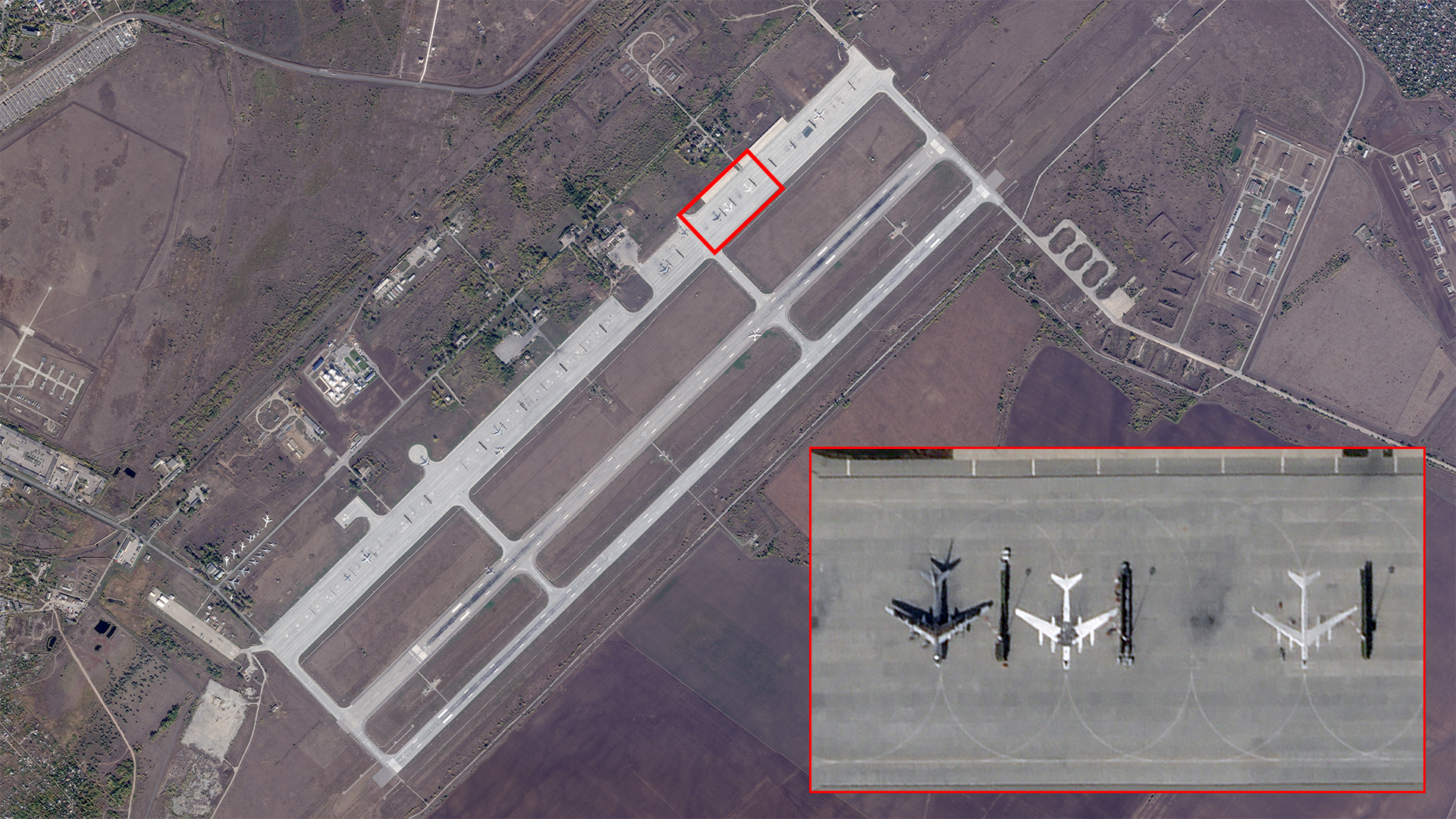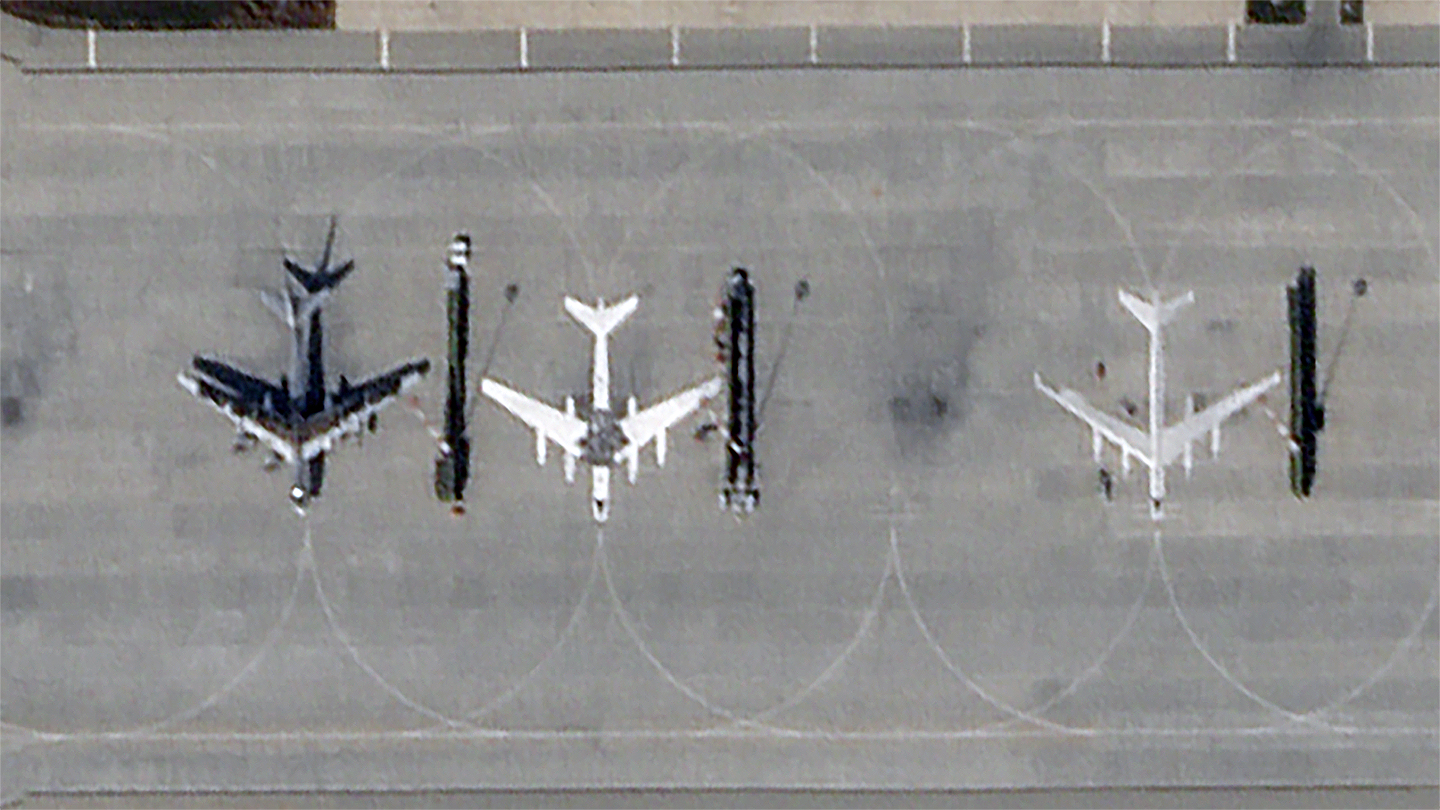Satellite imagery shows Russia is now painting the silhouettes of Tu-95MS “Bear-H” strategic bombers in parking revetments at its master bomber base, Engels Air Base, also known as Engels-2. The base has come under repeated attack over the last year and as Ukraine’s standoff weapons capabilities are rapidly evolving, so are its abilities to strike deep inside Russia using local sabotage and drone attack teams.
Planet Labs satellite imagery obtained by The War Zone that was taken on Sept. 29 shows the two-dimensional decoys adorned on Engels’ tarmac — a near ‘copy-paste’ of the four-engine bomber’s distinctive planform right down to its black-painted cockpit area. A second painted decoy appears partially complete next to the finished one. It’s worth noting that it is possible that these are some sort of low profile cloth/canvas or other decoy, but it has little to no vertical dimension, so paint is most likely.

What’s also of interest is that the finished painted-on decoy has tires laying across its central wing and fuselage area, just like the real Tu-95 to the left of it. This is clearly added for realism in hopes the decoy will prove more convincing as the tires are now a common countermeasure that is used by some Russian Air Force aircraft while parked.
The painted decoys could have a number of any objectives. The primary one is likely to fool satellites and in effect disrupt any Ukrainian strike operations ‘left of launch’ (before they are even executed) by providing faulty targeting data. But this clearly will not work as even limited high-resolution commercial satellite imagery can clearly distinguish between the silhouettes and real aircraft. Using multiple intelligence sources, such as synthetic aperture radar (SAR) satellite imagery (also available commercially), would make it clear that the target is not a three-dimensional object. Still, the tactic could work with low-resolution imaging satellites and we have seen a similar applications in the past. In other words, painting false silhouettes ramps is not new, it just is far less relevant than it was not very long ago. Still, it’s not like Russia doesn’t invest in antiquated countermeasures to a puzzling degree.
It may also be hoped that the ‘false Bears’ would confuse drone operators executing localized attacks, but that seems like a major reach in reality. Still, such attacks would ostensibly take place at night and in otherwise poor visibility to limit detection, and sorting out real from fake bombers with lower-end low-light sensors may be more challenging. The use of various paints with infrared reflective or absorbative properties can also be used to maximize the countermeasure’s effect. In August, Ukrainian drone operators destroyed an Il-76 “Candid” heavy cargo aircraft and a Tu-22M “Backfire” bomber in localized drone attacks.
It’s possible, that like the tires, the painted on Bears could be aimed at confusing the infrared targeting sensors on standoff weaponry, like cruise missiles, that use autonomous image matching. How effective that may be is unclear, especially considering this would be a two dimensional object that would not benefit from the same decoy effects when viewed at various shallower angles compared to directly overhead.
The Tu-95 fleet, alongside the Russian Long Range Aviation’s Tu-160 “Blackjack” and Tu-22M Backfire bombers, have launched hundreds of cruise missiles as the workhorses of Moscow’s air campaign against targets deep inside Ukraine.

They are also particularly valuable and near-impossible to replace. Russia’s operational doctrine also means there are few hangars on its bomber bases to conceal these aircraft. As such, they are left in the elements and exposed to targeting and subsequent destruction via aerial attack.
It thus makes sense why Russia would take extra steps, no matter how fleeting, to limit the bombers’ potential exposure on the ground. Last month it was tires. This month it is painting Tu-95 silhouettes on the tarmac.
Contact the author: stetson.payne@thewarzone.com
